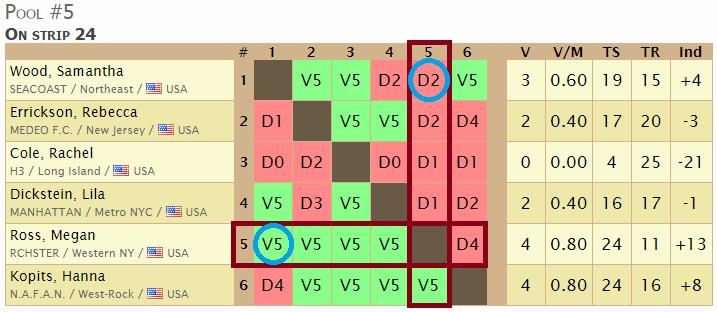This post is to help de-mystify the pool results you’ll see online or in event “live result” websites and to understand how they influence the seeding of fencers for the Direct Elimination (DE) rounds at tournaments like the SYC. Many of your fencers will have fenced in smaller events such as RFC Challenges and perhaps similar sized events close by, but you may have never seen a pool results sheet or the resulting DE seeding chart. It’s helpful to understand how this works, especially in larger events with more than 2 or 3 different pool groups.
When your fencer is assigned to a pool, that’s typically a group of 6 or 7 where each fencer competes in a bout to five touches with every other fencer in their pool. Pool bouts are time-limited for epee and foil to three minutes, so it’s possible that some bouts don’t go to five. The results of a pool look like this (taken from one of my daughter Megan’s recent tournaments):

This chart keeps track of who won and lost each bout, and also how many points were scored for and against each fencer. Megan was fencer #5 in this pool, so you can see how many points she scored in each of her five bouts by looking across her row. So against fencer #1, she scored 5 points. To see how many points her competitor scored in the same bout, you look at column 5 for the competitor’s line. So for the highlighted bout of Megan (Fencer #5), against Wood (Fencer #1), Megan won 5-2.
Looking across Megan’s row #5, you can see she won four of five bouts. That’s also shown in the “V” column in the right hand portion of the chart. After the “V” column is the “V/M” column, which is the percent of her bouts won. This percent of bouts won is the first stat used in seeding the Direct Elimination round.
“TS” is Touches Scored, this is the total number of points scored in all bouts, and “TR” is Touches Received, which is how many points were scored against.
The final column in the above chart, “Ind”, is the difference between touches scored for and against. If this number is positive, then the fencer scored more points than were scored against them. If it is negative, then they had more points scored against. This is tie-breaker for seeding (after percent won). The larger this number, the better. So even if two fencers both win 3 and lose 3, one still performed better by scoring more points and/or have fewer scored against them. Even in losing bouts, the actual score matters as well, which is why it’s important to never give up!
Once pools are done, a table is generated that looks like this:

This post-pool seeding is used to determine which fencers compete against each other in Direct Elimination bouts. The order of the seeding is:
- Percent of pool bouts won (the “V/M” column)
- Indicator of points-for vs. points-against in pool bouts (the “Ind” column)
So, Megan was seeded 7th in this tournament for the DE round after pools. This is based on winning 80% of her pool bouts, and her indicator was +13. The 8th seeded fencer also won 80% of her pool bouts, but her indicator was +10 which is placed below +13.
One thing you can help with as a parent is to keep track of the scores of your child’s pool bouts. At the end of pools, your fencer will sign the pool sheet, indicating your fencer agrees it’s correct. Your fencer will probably remember the scores but can check with you if she/he has any questions before signing. Referees occasionally make mistakes on this, and one point off or a transposed result definitely will affect your fencer’s seeding in the DE round!
Next month’s Parent’s Corner will continue this discussion into how the Direct Elimination bracket works, who fences who first in the DE, and why some fencers get a bye for the first round of the DEs.



